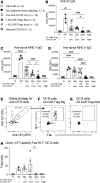CAR Treg synergy with anti-CD154 promotes infectious tolerance and dictates allogeneic heart transplant acceptance
- PMID: 40197364
- PMCID: PMC11981628
- DOI: 10.1172/jci.insight.188624
CAR Treg synergy with anti-CD154 promotes infectious tolerance and dictates allogeneic heart transplant acceptance
Abstract
Successful allograft-specific tolerance induction would eliminate the need for daily immunosuppression and improve posttransplant quality of life. Adoptive cell therapy with regulatory T cells expressing donor-specific chimeric antigen receptors (CAR Tregs) is a promising strategy but, as monotherapy, cannot prolong survival with allografts with multiple MHC mismatches. Using an HLA-A2-transgenic haplo-mismatched heart transplantation model in immunocompetent C57BL/6 recipients, we showed that HLA-A2-specific CAR (A2.CAR) Tregs were able to synergize with a low dose of anti-CD154 to enhance graft survival. Using haplo-mismatched grafts expressing the 2W-OVA transgene and tetramer-based tracking of 2W- and OVA-specific T cells, we showed that in mice with accepted grafts, A2.CAR Tregs inhibited donor-specific T cell, B cell, and antibody responses and promoted a substantial increase in endogenous FOXP3+ Tregs with indirect donor specificity. By contrast, in mice where A2.CAR Tregs failed to prolong graft survival, FOXP3- A2.CAR T cells preferentially accumulated in rejecting allografts, and endogenous donor-specific responses were not controlled. This study therefore provides evidence for synergy between A2.CAR Tregs and CD154 blockade to promote infectious tolerance in immunocompetent recipients of haplo-mismatched heart grafts and defines features of A2.CAR Tregs when they fail to reshape host immunity toward allograft tolerance.
Keywords: Immunology; Therapeutics; Tolerance; Transplantation.
Conflict of interest statement
Figures






Update of
-
CAR Treg synergy with anti-CD154 mediates infectious tolerance to dictate heart transplant outcomes.bioRxiv [Preprint]. 2024 Oct 28:2024.09.20.614149. doi: 10.1101/2024.09.20.614149. bioRxiv. 2024. Update in: JCI Insight. 2025 Apr 08;10(7):e188624. doi: 10.1172/jci.insight.188624. PMID: 39386649 Free PMC article. Updated. Preprint.
Similar articles
-
CAR Treg synergy with anti-CD154 mediates infectious tolerance to dictate heart transplant outcomes.bioRxiv [Preprint]. 2024 Oct 28:2024.09.20.614149. doi: 10.1101/2024.09.20.614149. bioRxiv. 2024. Update in: JCI Insight. 2025 Apr 08;10(7):e188624. doi: 10.1172/jci.insight.188624. PMID: 39386649 Free PMC article. Updated. Preprint.
-
Anti-HLA-A2-CAR Tregs prolong vascularized mouse heterotopic heart allograft survival.Am J Transplant. 2022 Sep;22(9):2237-2245. doi: 10.1111/ajt.17063. Epub 2022 Apr 27. Am J Transplant. 2022. PMID: 35434896 Free PMC article.
-
Expression of a Chimeric Antigen Receptor Specific for Donor HLA Class I Enhances the Potency of Human Regulatory T Cells in Preventing Human Skin Transplant Rejection.Am J Transplant. 2017 Apr;17(4):931-943. doi: 10.1111/ajt.14185. Epub 2017 Feb 1. Am J Transplant. 2017. PMID: 28027623
-
Chimeric Antigen Receptor (CAR) Regulatory T-Cells in Solid Organ Transplantation.Front Immunol. 2022 May 26;13:874157. doi: 10.3389/fimmu.2022.874157. eCollection 2022. Front Immunol. 2022. PMID: 35720402 Free PMC article. Review.
-
Cell therapy in transplantation: A comprehensive review of the current applications of cell therapy in transplant patients with the focus on Tregs, CAR Tregs, and Mesenchymal stem cells.Int Immunopharmacol. 2021 Aug;97:107669. doi: 10.1016/j.intimp.2021.107669. Epub 2021 May 6. Int Immunopharmacol. 2021. PMID: 33965760 Review.
Cited by
-
Revolutionizing Allogeneic Graft Tolerance Through Chimeric Antigen Receptor-T Regulatory Cells.Biomedicines. 2025 Jul 18;13(7):1757. doi: 10.3390/biomedicines13071757. Biomedicines. 2025. PMID: 40722827 Free PMC article. Review.
References
MeSH terms
Substances
Grants and funding
LinkOut - more resources
Full Text Sources
Medical
Research Materials

